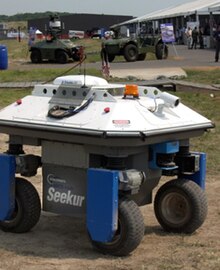An autonomous robot, also known as simply an autorobot or autobot, is a robot that performs behaviors or tasks with a high degree of autonomy (without external influence). Autonomous robotics is usually considered to be a subfield of artificial intelligence, robotics, and information engineering. Early versions were proposed and demonstrated by author/inventor David L. Heiserman.
Autonomous robots are particularly desirable in fields such as spaceflight, household maintenance (such as cleaning), waste water treatment, and delivering goods and services.
Some modern factory robots are "autonomous" within the strict confines of their direct environment. It may not be that every degree of freedom exists in their surrounding environment, but the factory robot's workplace is challenging and can often contain chaotic, unpredicted variables. The exact orientation and position of the next object of work and (in the more advanced factories) even the type of object and the required task must be determined. This can vary unpredictably (at least from the robot's point of view).
One important area of robotics research is to enable the robot to cope with its environment whether this be on land, underwater, in the air, underground, or in space.
A fully autonomous robot can:
- Gain information about the environment
- Work for an extended period without human intervention
- Move either all or part of itself throughout its operating environment without human assistance
- Avoid situations that are harmful to people, property, or itself unless those are part of its design specifications
An autonomous robot may also learn or gain new knowledge like adjusting for new methods of accomplishing its tasks or adapting to changing surroundings.
Like other machines, autonomous robots still require regular maintenance.
Components and criteria of robotic autonomy
Self-maintenance
The first requirement for complete physical autonomy is the ability for a robot to take care of itself. Many of the battery-powered robots on the market today can find and connect to a charging station, and some toys like Sony's Aibo are capable of self-docking to charge their batteries.
Self-maintenance is based on "proprioception", or sensing one's own internal status. In the battery charging example, the robot can tell proprioceptively that its batteries are low and it then seeks the charger. Another common proprioceptive sensor is for heat monitoring. Increased proprioception will be required for robots to work autonomously near people and in harsh environments. Common proprioceptive sensors include thermal, optical, and haptic sensing, as well as the Hall effect (electric).
Sensing the environment
Exteroception is sensing things about the environment. Autonomous robots must have a range of environmental sensors to perform their task and stay out of trouble.
- Common exteroceptive sensors include the electromagnetic spectrum, sound, touch, chemical (smell, odor), temperature, range to various objects, and altitude.
Some robotic lawn mowers will adapt their programming by detecting the speed in which grass grows as needed to maintain a perfectly cut lawn, and some vacuum cleaning robots have dirt detectors that sense how much dirt is being picked up and use this information to tell them to stay in one area longer.
Task performance
The next step in autonomous behavior is to actually perform a physical task. A new area showing commercial promise is domestic robots, with a flood of small vacuuming robots beginning with iRobot and Electrolux in 2002. While the level of intelligence is not high in these systems, they navigate over wide areas and pilot in tight situations around homes using contact and non-contact sensors. Both of these robots use proprietary algorithms to increase coverage over simple random bounce.
The next level of autonomous task performance requires a robot to perform conditional tasks. For instance, security robots can be programmed to detect intruders and respond in a particular way depending upon where the intruder is.
For a robot to associate behaviors with a place (localization) requires it to know where it is and to be able to navigate point-to-point. Such navigation began with wire-guidance in the 1970s and progressed in the early 2000s to beacon-based triangulation. Current commercial robots autonomously navigate based on sensing natural features. The first commercial robots to achieve this were Pyxus' HelpMate hospital robot and the CyberMotion guard robot, both designed by robotics pioneers in the 1980s. These robots originally used manually created CAD floor plans, sonar sensing and wall-following variations to navigate buildings. The next generation, such as MobileRobots' PatrolBot and autonomous wheelchair, both introduced in 2004, have the ability to create their own laser-based maps of a building and to navigate open areas as well as corridors. Their control system changes its path on the fly if something blocks the way.
At first, autonomous navigation was based on planar sensors, such as laser range-finders, that can only sense at one level. The most advanced systems now fuse information from various sensors for both localization (position) and navigation. Systems such as Motivity can rely on different sensors in different areas, depending upon which provides the most reliable data at the time, and can re-map a building autonomously.
Rather than climb stairs, which requires highly specialized hardware, most indoor robots navigate handicapped-accessible areas, controlling elevators, and electronic doors. With such electronic access-control interfaces, robots can now freely navigate indoors. Autonomously climbing stairs and opening doors manually are topics of research at the current time.
As these indoor techniques continue to develop, vacuuming robots will gain the ability to clean a specific user-specified room or a whole floor. Security robots will be able to cooperatively surround intruders and cut off exits. These advances also bring concomitant protections: robots' internal maps typically permit "forbidden areas" to be defined to prevent robots from autonomously entering certain regions.
Outdoor autonomy is most easily achieved in the air, since obstacles are rare. Cruise missiles are rather dangerous highly autonomous robots. Pilotless drone aircraft are increasingly used for reconnaissance. Some of these unmanned aerial vehicles (UAVs) are capable of flying their entire mission without any human interaction at all except possibly for the landing where a person intervenes using radio remote control. Some drones are capable of safe, automatic landings, however. An autonomous ship was announced in 2014—the Autonomous spaceport drone ship—and is scheduled to make its first operational test in December 2014.
Outdoor autonomy is the most difficult for ground vehicles, due to:
- Three-dimensional terrain
- Great disparities in surface density
- Weather exigencies
- Instability of the sensed environment
Open problems in autonomous robotics
There are several open problems in autonomous robotics which are special to the field rather than being a part of the general pursuit of AI. According to George A. Bekey's Autonomous Robots: From Biological Inspiration to Implementation and Control, problems include things such as making sure the robot is able to function correctly and not run into obstacles autonomously.
- Energy autonomy and foraging
Researchers concerned with creating true artificial life are concerned not only with intelligent control, but further with the capacity of the robot to find its own resources through foraging (looking for food, which includes both energy and spare parts).
This is related to autonomous foraging, a concern within the sciences of behavioral ecology, social anthropology, and human behavioral ecology; as well as robotics, artificial intelligence, and artificial life.
History and development
The Seekur robot was the first commercially available robot to demonstrate MDARS-like capabilities for general use by airports, utility plants, corrections facilities and Homeland Security.
The Mars rovers MER-A and MER-B (now known as Spirit rover and Opportunity rover) can find the position of the sun and navigate their own routes to destinations, on the fly, by:
- Mapping the surface with 3D vision
- Computing safe and unsafe areas on the surface within that field of vision
- Computing optimal paths across the safe area towards the desired destination
- Driving along the calculated route;
- Repeating this cycle until either the destination is reached, or there is no known path to the destination
The planned ESA Rover, ExoMars Rover, is capable of vision based relative localisation and absolute localisation to autonomously navigate safe and efficient trajectories to targets by:
- Reconstructing 3D models of the terrain surrounding the Rover using a pair of stereo cameras
- Determining safe and unsafe areas of the terrain and the general "difficulty" for the Rover to navigate the terrain
- Computing efficient paths across the safe area towards the desired destination
- Driving the Rover along the planned path
- Building up a navigation map of all previous navigation data
During the final NASA Sample Return Robot Centennial Challenge in 2016, a rover, named Cataglyphis, successfully demonstrated fully autonomous navigation, decision-making, and sample detection, retrieval, and return capabilities. The rover relied on a fusion of measurements from inertial sensors, wheel encoders, Lidar, and camera for navigation and mapping, instead of using GPS or magnetometers. During the 2 hour challenge, Cataglyphis traversed over 2.6 km and returned five different samples to its starting position.
The DARPA Grand Challenge and DARPA Urban Challenge have encouraged development of even more autonomous capabilities for ground vehicles, while this has been the demonstrated goal for aerial robots since 1990 as part of the AUVSI International Aerial Robotics Competition.
Between 2013 and 2017, Total S.A. has held the ARGOS Challenge to develop the first autonomous robot for oil and gas production sites. The robots had to face adverse outdoor conditions such as rain, wind and extreme temperatures.
Delivery robot
A delivery robot is an autonomous robot used for delivering goods.
Construction robots
Construction robots are used directly on job sites and perform work such as building, material handling, earthmoving, and surveillance.
Numerous companies have robotics applications in stages ranging from R&D to fully-commercialized.
- ASI Robots: heavy equipment automation and autonomy platform
- Builder [X]: heavy equipment automation
- Built Robotics: heavy equipment automation
- Doxel: autonomous surveillance and job site tracking
- EquipmentShare: equipment automation and remote control
- Fastbrick Robotics: bricklaying robot
- Jaybridge Robotics: heavy equipment automation
- Robo Industries: heavy equipment automation
- SafeAI: heavy equipment automation
- Scaled Robotics: autonomous surveillance and job site tracking
- Semcon: autonomous compactors and plows
- Steer: remote control operation
- Zoomlion: heavy equipment automation
Research and education mobile robots
Research and education mobile robots are mainly used during a prototyping phase in the process of building full scale robots. They are a scaled down versions of bigger robots with the same types of sensors, kinematics and software stack (e.g. ROS). They are often extendable and provide comfortable programming interface and development tools. Next to full scale robot prototyping they are also used for education, especially at university level, where more and more labs about programming autonomous vehicles are being introduced. Some of the popular research and education robots are:
- TurtleBot
- ROSbot 2.0
Legislation
In March 2016, a bill was introduced in Washington, D.C., allowing pilot ground robotic deliveries. The program was to take place from September 15 through the end of December 2017. The robots were limited to a weight of 50 pounds unloaded and a maximum speed of 10 miles per hour. In case the robot stopped moving because of malfunction the company was required to remove it from the streets within 24 hours. There were allowed only 5 robots to be tested per company at a time. A 2017 version of the Personal Delivery Device Act bill was under review as of March 2017.
In February 2017, a bill was passed in the US state of Virginia via the House bill, HB2016, and the Senate bill, SB1207, that will allow autonomous delivery robots to travel on sidewalks and use crosswalks statewide beginning on July 1, 2017. The robots will be limited to a maximum speed of 10 mph and a maximum weight of 50 pounds. In the states of Idaho and Florida there are also talks about passing the similar legislature.
It has been discussed that robots with similar characteristics to invalid carriages (e.g. 10 mph maximum, limited battery life) might be a workaround for certain classes of applications. If the robot was sufficiently intelligent and able to recharge itself using the existing electric vehicle (EV) charging infrastructure it would only need minimal supervision and a single arm with low dexterity might be enough to enable this function if its visual systems had enough resolution.[citation needed]
In November 2017, the San Francisco Board of Supervisors announced that companies would need to get a city permit in order to test these robots. In addition, sidewalk delivery robots have been banned from making non-research deliveries.










